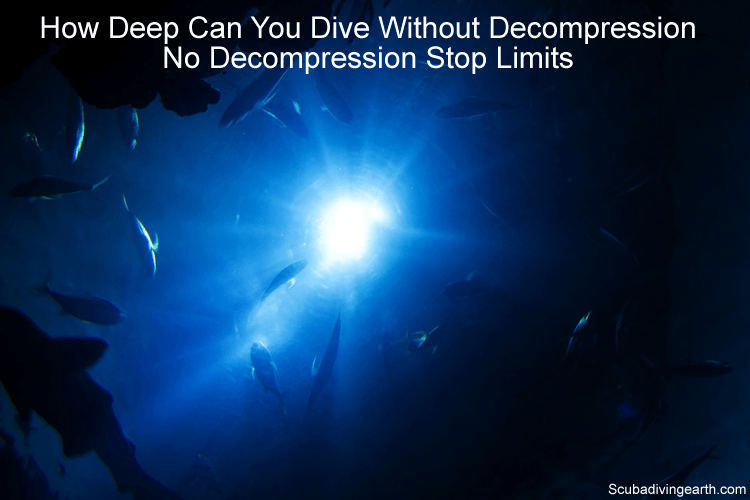
What are the depths scuba divers can dive without the need to worry about decompression stops?
Many scuba divers get confused between ‘decompression‘ and ‘decompression stops.’ This leads to a number of beginner scuba divers asking ‘how deep can you dive without decompression.’ If you get decompression wrong when you’re scuba diving, this can result in injury.
That’s why its important to get it right between how deep you dive and how you decompress at the end of your dive. All dives are decompression dives no matter how deep you dive, so you must decompress on your ascent. You must ascend slowly from all dive depths using your dive computer as a guide and end your dive on a 5-6 metre safety stop. If you exceed the no-stop decompression limit decompression stops are needed.
The best way to dive anywhere in the world is by a scuba diving liveaboard. You can check the latest and best deals on liveaboards using the following window:
As an aside, in this article about where to find great white sharks, you may be as surprised as I was to discover some of the places where you find great white sharks! Place number 6 is the one that surprised me the most, but if you live in the States, you may be more surprised at places two, three and four.
As all dives are decompression dives, and with the answer “You can’t dive without needing to decompress,” the next question to ask is ‘how deep can you dive without decompression stops?’
Decompression stops are affected by how deep you dive and also by how much time you spend at your chosen depth. Which is is why it’s important to know how deep you can dive without decompression stops. The deeper and longer your dive the more chance you need decompression stops. Shallow dives of 6-10 metres (20-30 feet) you can spend over 200 minutes without a decompression stop. Dives to over 30 metres (100 feet) limit your dive time to around 20 minutes before a decompression stop is required.
Please don’t leave before you watch the video in this article! Before you when you’ve got your answer about deep diving and decompression, you may like to watch the video on this article too. I almost don’t want to spoil the end of the video, so all I will say is it involves a carcass, many sharks and a single grouper…you may be surprised at what happens, I certainly was!

What is decompression?
Firstly, let’s look at what decompression is with regards to scuba diving.
If we look at the definition of decompression this states that: “Decompression is to release from pressure or compression” or “to undergo release from pressure.”
When you scuba dive you enter an environment which is at higher pressure than it is on land. In fact water is nearly 800 times (784 times) more dense than air at sea level.
The deeper you go, the higher the pressure. The higher the pressure the more your body will be compressed. So by definition, as you ascend from ANY dive your body will be decompressing. That means that all dives are decompression dives.
When your body is under pressure the nitrogen element (i.e. 78%) of the air you breath is dissolved into your body. The longer you are at depth the more nitrogen is dissolved. The more nitrogen that’s been dissolved, the more time that’s required for it to release from your body as you ascend and decompress.

How do scuba divers decompress?
Scuba divers decompress by ascending slowly. The gases (in particular nitrogen) that have dissolved into your bodily tissues under pressure at depth are released as you ascend, as the water pressure reduces.
If you ascend too quickly these gasses (i.e. nitrogen) would escape too quickly and form bubbles. It’s these nitrogen bubbles that are the problem.
It’s these nitrogen bubbles that cause decompression sickness (DCS).
DCS or the bends is potential fatal. This should therefore be avoided at all costs. This is why all scuba diving schools, navy training and other scuba diving experts advise you ascend at a slow rate.
Your ascent rate can either be controlled by using a dive computer. Or alternatively, you can ascend at a rate that’s slower than the smallest of your exhaust bubbles from breathing.
More Reading: 12 decompression sickness risk factors
What is a decompression stop?
As a part of your ascent from depth, if the amount of nitrogen dissolved into your body exceeds a certain level, you may need to stop at certain intervals during your ascent. These stops allow additional time for the dissolved gases to escape slowly. Before you continue with your ascent to the surface.
A stop during your ascent is called a decompression stop.
A decompression stop is similar to a safety stop, except that a decompression stop is mandatory. Whereas a safety stop is precautionary. Both serve similar purposes, but if you miss a decompression stop, you risk getting decompression sickness. If you miss a safety stop you are less likely to run into problems.
However, it’s worth taking note of the decompression sickness risk factors. There are certain risk factors that could impact on your decompression time and on a safety stop becoming even more important.
More Reading: How do you do a decompression stop vs a safety stop?
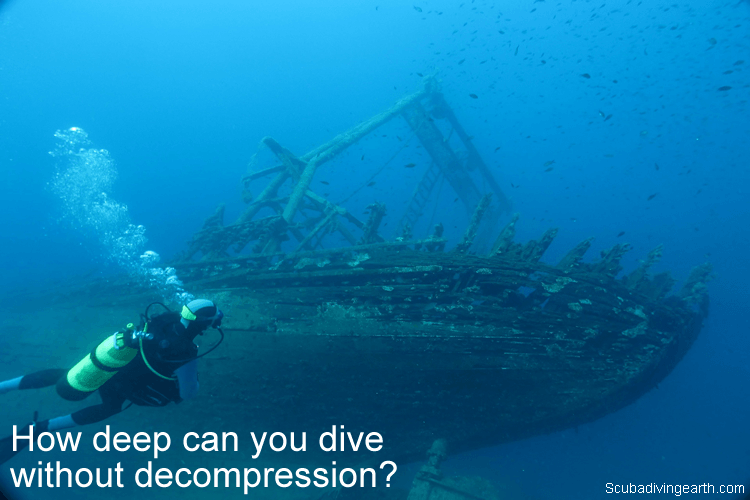
How deep can you dive without decompression in more detail?
As already explained, all dives are decompression dives. I’m therefore going to explain more about ‘how deep and how long can you dive without a decompression stop,’ instead of about ‘how deep can you dive without decompression or without needing to decompress?‘
The depth to which you dive and how long you stay at that depth will impact your decompression time. So it’s not necessarily just about the depth you dive to on its own.
It’s about a combination of the two variables that make the difference. Which are;
- The depth of your dive, and;
- How long you dive for or ‘your bottom time‘.
For example, you could probably spend many hours at a depth of between 6-10 metres (20-30 feet), without having to worry about a decompression stop. For example 243 minutes at 9 metres.
Your air is more likely to run out way before a decompression stop would become necessary. But you still need to ascend slowly from this depth in the same way you need to from a deeper dive.
As you begin to dive deeper the time you spend at these deeper depths will impact the time you can spend on the bottom before you need to factor in decompression stops.
Below are a few examples of the amount of time you can spend at certain depths before requiring a decompression stop.
Notice in the table below how your time is restricted at depths of more than 20-25 metres (66-82 feet).
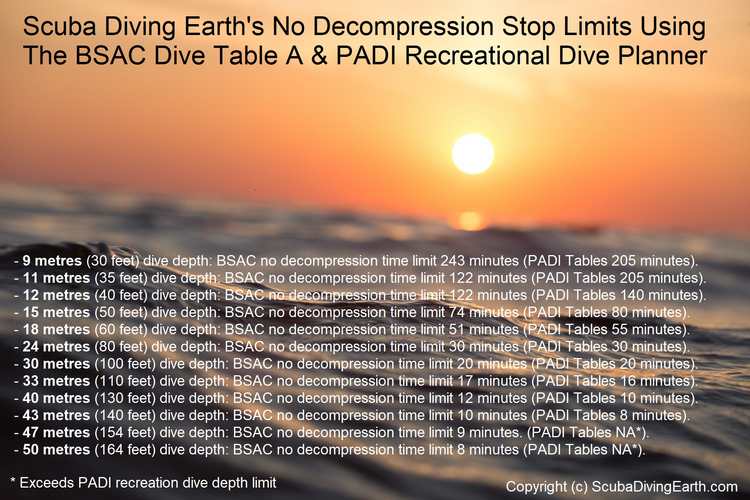
Examples of no decompression stop time limits at various depths using BSAC dive tables (Using Table A)
The following depths and no stop decompression times are based on the first dive of the day. Which means it assumes you’ve not done any other dives beforehand.
BSAC and PADI no-stop dive times:
- 9 metres (30 feet) dive depth: BSAC no decompression time limit of 243 minutes (PADI Tables 205 minutes).
- 11 metres (35 feet) dive depth: BSAC no decompression time limit 122 minutes (PADI Tables 205 minutes).
- 12 metres (40 feet) dive depth: BSAC no decompression time limit 122 minutes (PADI Tables 140 minutes).
- 15 metres (50 feet) dive depth: BSAC no decompression time limit of 74 minutes (PADI Tables 80 minutes).
- 18 metres (60 feet) dive depth: BSAC no decompression time limit of 51 minutes (PADI Tables 55 minutes).
- 24 metres (80 feet) dive depth: BSAC no decompression time limit of 30 minutes (PADI Tables 30 minutes).
- 30 metres (100 feet) dive depth: BSAC no decompression time limit of 20 minutes (PADI Tables 20 minutes).
- 33 metres (110 feet) dive depth: BSAC no decompression time limit of 17 minutes (PADI Tables 16 minutes).
- 40 metres (130 feet) dive depth: BSAC no decompression time limit of 12 minutes (PADI Tables 10 minutes).
- 43 metres (140 feet) dive depth: BSAC no decompression time limit of 10 minutes (PADI Tables 8 minutes).
- 47 metres (154 feet) dive depth: BSAC no decompression time limit 9 minutes. (PADI Tables NA*).
- 50 metres (164 feet) dive depth: BSAC no decompression time limit of 8 minutes (PADI Tables NA*).
* Exceeds PADI recreation dive depth limit.
See below for a handy table of no-stop decompression time limits for BSAC and PADI dive tables.
If you go over any of these dive time limits at the depths shown, you will take yourself into decompression stop time.
More Reading: What are the common depths for experience scuba divers?
Once you enter decompression stop time diving you’ll need to take into account your air consumption for the duration of your decompression stop(s). Whilst you’re stopped to decompress you are consuming air.
Have you heard about the ‘Scuba Diving Lizard’? Take a read of this article about a lizard that can breathe underwater from a scuba-tank like bubble…I was fascinated when I read this!
For decompression stop dives you need to consider the following:
- How much air is needed for your descent.
- The air you consume on the dive (i.e. bottom time).
- How much air you’ll consume during your decompression stops.
- The amount of air you’ll use during your ascent between decompression stops.
- Your air consumption on your 3 minute safety stop.
- Whilst always remembering to return to the surface with your reserve air.
More Reading: How deep can you dive with Nitrox?
How deep can you dive without a safety stop?
As already explained a safety stop is a precautionary stop on your ascent from a dive. If for example your dive is to a shallow depth of between 6-10 metres (20-30 feet) a safety stop isn’t necessary.
However, once you go deeper than 10-15+ metres (30-50+ feet), then I’d always recommend you carry out a 5-6 metres (16-20 feet) safety stop for three minutes for every dive you do.
Most dive organisations recommend this. Plus most dive companies insist on you performing a safety stop.
More Reading: Emergency decompression stop vs safety stop
BSCA and PADI No Decompression Stop Time Limits Table
| Dive Depth Metres | Dive Depth Feet | BSAC No-Stop Dive Time Limit Minutes | PADI No Stop Dive Time Limit Minutes |
|---|---|---|---|
| 09 | 30 | 243 | 205 |
| 11 | 35 | 122 | 205 |
| 12 | 40 | 122 | 140 |
| 15 | 50 | 074 | 080 |
| 18 | 60 | 051 | 055 |
| 21 | 70 | 037 | 040 |
| 24 | 80 | 030 | 030 |
| 27 | 90 | 024 | 025 |
| 30 | 100 | 020 | 020 |
| 33 | 110 | 017 | 016 |
| 37 | 120 | 013 | 013 |
| 40 | 130 | 012 | 010 |
| 43 | 140 | 010 | 008 |
| 47 | 154 | 009 | NA* |
| 50 | 164 | 008 | NA* |
1. The above dive depths and no-stop decompression dive times for BSAC are from Table A.
2. The above dive depths and no-stop decompression dive times for PADI are taken from PADI's Recreational Dive Planner using Pressure Group A.
NA* = Exceeds PADI recreation dive depth limit.
Please don’t leave before you watch the video in this article! So before you, you may like to watch the video on this article too. I almost don’t want to spoil the end of the video, so all I will say is it involves a carcass, many sharks and a single grouper…you may be surprised at what happens, I certainly was! Or take a look at the most surprising places where to find great white sharks!
I hope you enjoyed this article about how deep can you dive without decompression (stops)
I’d love to hear from you. Tell us about your adventures of diving and snorkeling, in the comments below. Please also share your photos. Either from your underwater cameras or videos from your waterproof Gopro’s!
If this article hasn’t answered all of your questions. If you have more questions either about snorkeling or scuba diving (or specifically about how deep can you dive without decompression (stops)), please comment below with your questions.
There will also be many more articles about scuba diving (and snorkeling) for you to read and learn about these fabulous sports.
Have fun and be safe!
#DCSStopLimits
More Reading to enjoy: What are the advantages of Nitrox diving?

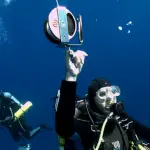


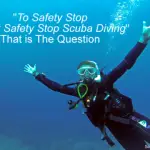
so as I am using a surface air system (hookah diving) is there any difference in doing decompression stops at less than 30 ft depth. is there a difference between regular compressed air in a scuba tank and breathing low compression surface air as from a surface food grade air compressor pump?? any input will be much appreciated .
Hello and thank you for your question.
Regardless of how you’re breathing the air underwater at depth, be it from a compressed-air scuba tank (or aqua lung) or your method using a Hookah diving surface air system, this won’t have any affect on your uptake of nitrogen in your body at depth. That means you will still need to be careful on your ascent and you will still need to carry out decompression stops if you exceed the ‘no decompression stop limit’, as set out in my article above.
Having said that, at a depth of just 30 feet or roughly 9 metres, you are unlikely to ever require a decompression stop at this depth. Although, as you’ve asked this question, I have now added this depth to the list in my article. At a depth of 9 metres (30 feet) using the BSAC table A, your no decompression time limit is 243 minutes. But using the PADI tables their’s starts at 10 metres (33 feet) and the max no decompression time limit is 219 minutes at this depth.
So long as you don’t exceed these time limits you won’t need to stop for decompression. But as with any dive to depth, I always recommend a safety stop at between 5-6 metres (16-20 feet), to be on the safe side.
Be mindful of your second dive of the day, as these dive time limits are based on your first dive and they assume you’ve not done any other dives beforehand.
But as another precaution and for your own safety, please make sure you never hold your breath and always breath normally – please take a read of this article, just in case: https://www.scubadivingearth.com/what-is-the-most-important-rule-in-scuba-diving-never-hold-your-breath/
The other consideration is the use of Nitrox, which is air enriched with oxygen to different percentages – you may want to take a read of these article too: https://www.scubadivingearth.com/how-deep-can-you-dive-with-nitrox-why-should-i-dive-with-nitrox/ and
https://www.scubadivingearth.com/what-are-the-advantages-of-nitrox-diving-pros-and-cons-of-nitrox-diving/
If you have any other questions, please ask.
Take care and happy diving! Russell